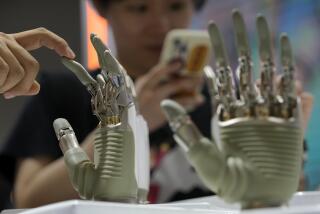Op-Ed: Art is essential and so are the people who create it. We have to start treating them that way

Thereâs never been a better time to be an artist â not, that is, if you believe the story that has long been peddled by Silicon Valley. If youâve got a laptop, youâve got a recording studio. If youâve got an iPhone, youâve got a movie camera. And distribution is free â itâs called the internet. Just put your stuff out there, and soon you, too, can make a living doing what you love, just like all those viral stars you read about.
But the story has some major flaws. You can certainly just put your stuff out there, but youâre going to have a lot of trouble getting anyone to pay you for it.
And production and distribution are not the main costs of making art. That would be staying alive while you do your work and becoming an artist in the first place.
Staying alive means, principally, rent. According to the Census Bureau, median rent nationwide is up 42%, adjusted for inflation, since 2000. For most artists, becoming an artist means going to college, then perhaps getting an MFA, and tuitions have been soaring for years.
Yes, being an artist has always been hard, but how hard matters. How hard it is affects how much you get to do your art, as opposed to grinding at your day job, and therefore how good you become, as well as how much you are able to produce.
How hard it is affects who gets to do art at all. Art shouldnât be a rich personâs game. And wealth correlates with race and gender. If you care about diversity, you need to care about economics. The idea that artists will make art no matter what is the product of naivete, ignorance or privilege.
Even if you do achieve a modicum of success as an artist â work full time in the field; reach listeners, readers or viewers; win the respect of critics and peers â your career may still not be sustainable in the digital age.
Because of their enormous size, wealth and market dominance, Amazon, Google and Facebook have been able to flout copyright law and dictate prices and other terms to record labels, publishers and independent artists of all kinds. For example, YouTube, which is owned by Google, has been estimated to pay musicians a larcenous, insulting 0.07 cents per stream, or $700 for 1 million streams.
And all that was before the pandemic. Now theaters and galleries are closed; concerts have been canceled; film and television production is just beginning to crawl back. In a survey by the Authors Guild, 60% of members reported a drop in income since the crisis started. One visual artist told me that a friend of his had five exhibitions canceled.
âI got a heartbreaking mass email from a fellow musician this morning,â a singer-songwriter said, âwho described going out and sitting in his touring van and crying.â
There is widespread hope across society that the pandemic will provide the opportunity for a reset, that the crisis will force into existence a more equitable economy. What would that look like for the arts?
Start with public funding. In 2019, at all levels of government, the U.S. spent the comically tiny sum of $1.38 billion on the arts â or 0.0064% of GDP. Across the European Union, the average, as of 2017, was 0.4% of GDP, or 63 times as high.
We also need to end the assumption that content should be free. If you consume artistsâ work, you have to pay for it.
But public funding will only ever represent a small fraction of the arts economy, and consumer purchases will only go so far, especially when the audience itself is strapped for cash. The problems for artists are structural; the solutions must be structural. Artists are the original gig workers, still working under labor laws and regulations fashioned for a bygone economy.
Gig workers need the kinds of safeguards that full-time employees have long enjoyed â healthcare and other benefits, protections against discrimination and harassment, the right to engage in collective bargaining. Californiaâs AB 5 is a start, though for artists, not necessarily a good one.
Above all, we must curb the power of Silicon Valley by breaking up the biggest players. Content may have been demonetized, but not for those who count the clicks. Between 2004 and 2015, according to Jonathan Taplin in âMove Fast and Break Things,â about $50 billion in annual revenue âmoved from the creators of content to the owners of monopoly platforms.â
When we shut ourselves away in March, we sought refuge in books, music, movies and narrative television. When demands for racial justice erupted in May, we looked to art to speak for marginalized communities and to articulate visions of social possibility. But we cannot have art unless we support the people who make it. Free content isnât free.
Warehouse workers, sales clerks, delivery drivers, health aides â the crisis has revealed just how essential, and how undervalued, these and many other workers are. The same is true of artists. Art is essential; the people who create it are essential, too.
William Deresiewiczâs latest book is âThe Death of the Artist: How Creators Are Struggling to Survive in the Age of Billionaires and Big Tech.â
More to Read
A cure for the common opinion
Get thought-provoking perspectives with our weekly newsletter.
You may occasionally receive promotional content from the Los Angeles Times.










